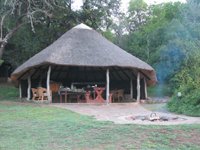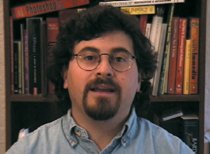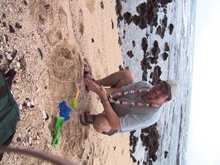| With some basics under your belt about framing your shots, we come to a bigger question: what shots are needed to create a movie? If you're shooting a family event, you may think the question doesn't apply to you; after all, you shoot whatever happens, right? Well, shooting the event itself is a good start, but you need more than that. And you need to make sure you have enough coverage, the footage that will give you plenty of room to work when you're editing in iMovie. Shoot to edit At the beginning of this chapter, I advised you to imagine the end result of your movie before you begin shooting. A similar notion is shooting to edit. In the days before anyone with a Mac could edit their movies, amateur filmmakers shot "in the camera," meaning they structured their shot process so that scenes fell sequentially in the order they would appear when the tape was played"editing" was done in advance by planning what to shoot. Now, you're shooting with the knowledge that your raw footage is going to be edited in iMovie. You don't have to shoot things in order, limit yourself to the main subject, or even use footage from the same session. By way of example, suppose you're filming a family reunion. Immediately following the pick-up basketball game (where Uncle Barney surprised everyone with 32 points and a slam dunk), you shoot a few minutes of a woodpecker perched on a nearby tree. Then you return to the festivities. The woodpecker has nothing to do with the family reunion, so you may not even use it in your final videoor perhaps you'll pop a few seconds of it into the beginning to show what a beautiful, nature-filled location everyone enjoyed. As another example, to round out your movie you want to show the sunset and then fade to black. Unfortunately, the sunset footage you shot wasn't as memorable as you remembered, so instead you grab 20 seconds of sunset footage you took on another location and insert that into your movie. Unless it's painfully obvious that the two locations are different (the presence of a sandy beach where before you were in the middle of a forest, for example), no one will know the difference, and your movie will end stronger. In each example, you had extra footage at your disposal because you were shooting to edit. Types of coverage When shooting a feature-length motion picture, a director will use multiple camera setups to shoot as much coverage as possible. So in one scene, the camera may shoot both actors in the frame, each actor from one or more different positions, and various combinations of points of view. The goal is to present a scene in the edited movie where the camera position is integral to the scene's mood or content. Establishing shot. This is usually an overview shot that's wide enough to let the viewer know the setting and which characters inhabit the scene (Figure 2.12). It can be a sign reading "Welcome to Twin Falls," a shot of someone's house, or a shot of a room. The important thing is that the establishing shot provides a physical geography of where objects appear. (This technique is used to great effect in dozens of movies and television shows: you see an establishing shot of the Chicago skyline and assume that the action takes place there, even though the actual filming took place in Vancouver.) Figure 2.12. An establishing shot gives the viewer a sense of where the scene is beginning, such as this shot of the campsite, where the next scenes will occur.  Medium shot. Most shots end up as variations of medium shots. Generally, this shot is large enough to frame two or three people's torsos, although it can vary between a shot of a single person or half of a room (Figure 2.13). Figure 2.13. A medium shot is typically close enough to include two or three people.  Close-up. The screen is filled with part of a person or object (Figure 2.14). Close-ups usually show a person's head and shoulders, but can also push in closer (known as an extreme close-up) so you see only the person's eyes. Other examples of close-ups include shots of a person's hands, or any object that occupies the entire frame. Figure 2.14. A close-up focuses on one person or object that occupies most of the frame.  Cut-away shots. Sometimes referred to as B-roll footage, cut-aways are shots of associated objects or scenes that aren't necessarily part of the central action in a scene. An example would be the view from a ship traveling through a passage, which cuts away to a shot of the darkening sky, then returns to the ship safely emerging from the passage. The woodpecker footage mentioned in the family reunion example earlier could easily be used as a cut-away shot. Cut-aways often prove invaluable when you need to cover up a few frames of a glitch or when cutting and shortening interviews. In points and out points. If possible, give yourself some shots that can be used to enter or exit a scene, sometimes known as in points and out points. For example, if you're shooting an interview and your subject has just declared his intention to walk on Mars, don't immediately stop recording. Hold the camera on him as he finishes speaking, then perhaps pan down to his desk where a model of his rocket ship is mounted.
Tips  | Linger on shots when you can. It's far easier to cut footage out than to add it back in later (especially if it's vacation footage or something similar... unless you really need to rationalize a trip back!). How long should you hold on to a shot? First of all, don't automatically shut off the camcorder just when the action has stopped. Stay for a few seconds or minutes to let the emotion of a scene dissipate. This is true when you're doing interviews or shooting wildlife. You can always trim it later in iMovie. Remember that a camcorder isn't like a still camera. I've seen people rotate the camcorder 90 degrees as they would a still camera in an effort to shoot a "taller" image (Figure 2.15). Unfortunately, no matter how you shoot, the end result will still be a horizontal imageit's not a print that you can view vertically. Figure 2.15. Resist the temptation to rotate your camcorder as you would a still camera to take "vertical" shots, because in video they'll look like this.  (That said, your footage can be salvaged. See Chapter 8 to learn how.) Here's a tip I came across while on a soggy camping trip. When shooting in poor weather, you'll need to protect your gear. You can buy hoods and covers and other accessories, which are fine but add bulk. Instead, I have a fleece vest that I use to cover the camera: the lens points through one arm hole, protecting it from the rain but still giving enough room for me to operate the camera.
|
|



